
Azgar Mukhamadiev
Turanian Writing
Article “Turanian Writing”, in the book “Problems Of Linguoethnohistory Of The
Tatar People” (Kazan, 1995. pp. 36-83)
I. Inscriptions on antique coins
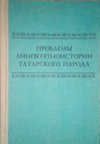
Links
http://kroraina.topcities.com/ca/c_khorezm.html
http://www.grifterrec.com/coins/centralasia/centralasia2.html
Posting Introduction
What started as a little trickle after the bonds of the Soviet Union fell apart, as a limited number of Turanian (i.e. Horesmian and Kangar) inscriptions on the coins and dishes collected and published soon after the Russian occupation of the Middle Asia, is turning into a torrent. With the alphabet already established fairly well, and ambiguities being resolved with a wealth of the new material, the reading of every new artifact becomes a matter of routine, approaching to the level of the scribes. By now, this little article is attaining a historiographical value, marking a milestone of first competent reading of the Turanian inscriptions that left in the dust a pile of preceding speculations. A century of hiatus, when those who knew the language and could freely read the texts did not know how to get them, and those who did not knew the language were treading in the tracks of the preconceived notions, came to a close with a steady stream of reading the old materials, and uncovering the new texts.
In the context of this work, Turan is the territory of Central Asia north and east of Amy-Darya, populated by nomadic Turanians variously called Sakas, Masguts/Massagetae, Kushans, Parthians, Ephtalites and other names of the consecutively Scythian, Hunnic, and Türkic tribes. In the Iranian folklore the Turanians are mentioned under a name Turya as early as the Farvardin Yashts (possibly 500BC) of the oldest Avesta, in the later mythology Turanians is a collective name for the eternal enemies of Zoroastrism, who are associated with the ruler Afrasiab (ca. 305-? AD) called Franrasyan in the Avesta hymns. Ethnically, Turan population consisted of symbiotic combination of ultimately Bactrian and Indian agricultural settlers of oases and river valleys, and Türkic nomadic and semi-nomadic population engaged in animal husbandry in the countryside, called by the later Avesta Sairimas, Sainus and Dahis. Of these, the Dahis are well-known Dahae/Tokhars/Dügers/Digors/Tuhsi, mentioned by Herodotus 5-7 centuries before their appearing in the Avesta. Repopulation of the Turan started in the 1st millennium BC, after a millennium-long desiccation period when the area was largely abandoned, and included waves of fast-moving Timber Grave animal husbandry nomads of the Kurgan Culture rolling down from the N.Pontic (western Tumber Gravers) and So.Siberian steppes (eastern Timber Gravers), and sluggish northward advance of the agriculturists from the Bactria, Afganistan, and India. The religious and political antagonism that precipitates the later Avesta does not reflect the mutually beneficial symbiosis enjoyed for two millennia by the Central Asian people in the belt stretching from the Caspian Sea to the Tarim basin, and the concept of Indo-European Urheimat connected with Eurasian steppe belt conflicts with archeological, genetical, biological, and any other type of scientific evidence. The coin legends point that Turan was within the Hunnic territory during the time of the Maodun Hunnic Empire (200 BC - 216 AD), or its western fraction after 166 AD.
 |
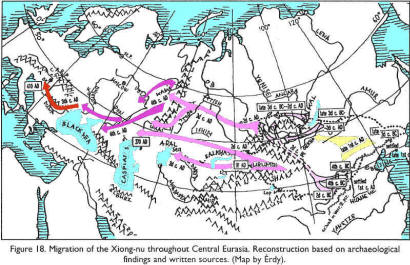 |
|---|
Turanian Writing
I. Inscriptions on antique coins
Table 1. Comparative chart of the Turanian and Turkic alphabets
Fig. 1. Khoresm imitation of a coin of Bactrian ruler Eucratid
Fig. 2. A Khoresm coin with a portrait of a local ruler, with distorted Latin inscription
Fig. 3. Antique Khoresm coin with an inscription “Turan Yabgu”
Fig. 4. A Khoresm coin with an inscription “Turan of Shad”
36
In the last century the Turanian or Khoresm coins with unknown inscriptions have already attracted attention of numismatists. One of such coins from the collection of St.Petersburg’s collector H.K.E Keller was published in German in the 1850 in St. Petersburg [Tolstov S.P., 1948, 173; Vainberg B.I., 1977, 9]. In the 1870 an English numismatist E.Thomas published an article “Indo-Parthian coins”,with five Khoresm coins sent for determination by a known numismatist V.Tizengauzen from St. Petersburg. Four of these coins were found in a bronze vessel in the Perm province. For the first time E.Thomas determined the Aramaic character of the alphabet of the inscriptions, and came to a conclusion about the affinity of one of them to the Bactrian mint, i.e. to a more ancient antique period.
In the 1938, the materials found in Khorezm allowed M.E.Masson to state in an article his judgment that the so-called Tarushki coins are from Khorezm. At the end of the 1938 came out an article of S.P. Tolstov, devoted to the Khoresm coins [Tolstov S.P., 1938]. The article offered a classification of the coins and their historical interpretation. The Khoresm archeological-ethnographic expedition began working in 1937. In only the first four years it found about 1000 coins. They were mainly copper coins, and were mainly found in the settlementToprak-Kale.
The analysis of the Khoresm coins coincidentally allowed to locate the cups with
inscriptions, composed in the same alphabet as the coin legends, among the silver
artifacts of the Kama region.
37
In 1953 B.M. Masson published an unique coin, an imitation of the tetradrakhma of the Greek-Bactrian ruler with a Khoresm tamga, i.e. a coin of the earliest minting [Masson B.M., 1953]. With the new monetary finds and classifications, B.I. Vainberg [Vainberg B.I., 1977] substantiated in detail the stages of the origin and the development of the monetary minting.
S.P.Tolstov also indicated in the mentioned article that the finding of the pre-Islamic Khoresm coins and Khoresm cups in the Kama region allows to consider as established the ancient close economic ties of these regions. New finds of the Khoresm coins from the Volga and Urals region confirm this judgment, allowing at the same time introduction of some refinements.
The existence of a united economic space in these regions is confirmed
by the numerous finds of the Khoresm coins and vessels made of precious metals.
It was mentioned that a wide interest of the numismatists was for the first time
attracted by the Khoresm coins found in the Kama region. The similar silver and
copper coins were found in the other parts of the Volga and Ural region. In the Bolshe-Tarkhan burial in the Republic of Tatarstan, for example, was found a
coin of Abdullah belonging to 8-th c. (Gening V.F., Khalikov A.Kh., 1964]. Only in one season of the 1981 the archeologists found a few
Khoresm coins. In the
Bartym burial of the Berezovsk region of the Perm area was found a copper coin in a very good
condition, with an image of a ruler with a camel hump on the top of the crown .
The next copper coin, less preserved, with an image of a king in a toothed
crown, was found in the Nevilinsk burial of the Kungur region in the Perm area.
Two more Khoresm coins were found at the Blagodatskiy I settlement in the Anash
region of the Udmurt Republic. The finds of the 1981 compelled the author of these
lines (because of the the need to classify the coins for the
Izhevsk archeologists' archeological reports) to closely study them and to formulate a completely new
explanation for the inscriptions of such coins
[Mukhamadiev A.G., 1990, 36-60].
39
The study of the coin inscriptions showed that a large number of the letters in the Khoresm alphabet were similar to the Türkic script. This similarity jumps into the eyes, especially in the inscriptions of the comparatively late Khoresm coins, and also draws an attention to the exact congruity of some Türkic and Khoresm letters. For example, on the coin from Bartym, the words of the inscription are not written with rounded letters, as on the early coins, but with runic type “printed” letters, i.e. there is an observable transition from the Turanian to the Türkic alphabet [Mukhamadiev A.G., 1994, 119].
In the Türkic writing monuments that reached us, from the beginning of the 8-th century, the areal of our interest where the Khoresm coins originate, i.e. the northern area of the Turkestan, is designated by the term Kengu Tarban or Kengu Tarman. The author of these lines was stunned by the similarity of the inscription, located in front of the face of the king on a coin from Bartym, and the words Kengu Tarman from the 21st line of the large inscription in honor of Bilge Khagan.
The Turanian alphabet reconstructed by me from the coin legends allows to read not only
inscriptions of the coins of 2-nd c. BC - 8-th c. AD, but also previously not
decoded inscriptions on the vessels of precious metals found in the Volga -
Ural basin, thus confirming that the chosen technique of decoding is correct (Table
1) [Mukhamadiev
A.G., 1990, 41, 59].
38
Comparative chart of the Turanian and Turkic alphabets (click to view)
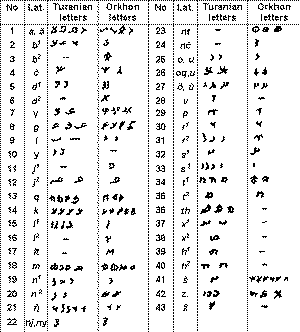
It seems that for a whole past generation of numismatists, the scornful attitude to the Hunno-Türkic civilization and disregard of the role of the ancient states played a malicious joke. For example, even the comparison of the name of the Türkic people Kangli with the antique state Kangüy was considered as “an anti-historical attempt” [Tolstov S.P., 1948, 24]. At the same time the initial period of minting of the Turanian coins coincides with the apex of the state of the Eastern Huns, and the second period of their minting coincides with the formation of Türkic Kaganate. For example, in 50-es of the 13-th c. AD the coins of Bulgar were minted with a name of Munke Khagan, enthroned in a faraway Mongolian Karakorum, though for the nomadic Mongols the monetary circulation was alien.
The inscriptions of coins shown
below are mostly taken from the works of S.P.Tolstov and B.I.Vainberg, who
classified numerous finds of coins from the excavation of Topak-kaly,
Berkut-kaly and other settlements. Especially advantageous in this respect is
the monograph of B.I.Vainberg, in which she gives not only systematic
illustrations of the coins, but also various variations of the inscriptions [Vainberg
B.I., 1977, Tab. I-VII].
40
| Fig. 1. Khoresm imitation of a coin of Bactrian ruler Eucratid | ||
|---|---|---|
 |
Tamga | |
| Inverted image | Sketch | |
 |
|
|
Before talking about inscriptions on Turanian coins it is necessary to say a few words of the chronological sequence of their minting.
The first coins were made in imitation to the coins of a Bactrian ruler Eucratid (Fig. 1,2). The years of his rule, and therefore, the chronological framework of the minting of the Eucratid coins are not established exactly. The expert in the antique coins A.N. Zograf believed that Eucratid coins were minted in the 200-150 BC [Zograf A.N., 1951, 235].
Not only the determination of the beginning, but also the sequence of the minting of
the Turanian coins is problematic. In the monograph, B.I.Vainberg gives a presumable chronology
of the monetary types. The sequence of the minting of the coins, as a whole, is
determined precisely. However, the coins inscription contents conflict
somewhat with this provisional concept. For example, the coins with an image of
a king in an eagle crown are inscribed with his title as Yabgu (Regent), which at once moves the coins
to the first position among the other coins of this period with the portraits of the
rulers, who, judging by the inscriptions, are only his subjects, Shads (Princes). That the last coins are a
little archaic in the form is explained, apparently, that usually the Shads
ruled in provincial centers. This explains a regular issue of the copper coins
on behalf of the Yabgu, i.e. a testimony that the coins were issued in the metropolitan city, where there was an intensive exchange and a demand for a large quantity of coins.
41
The chronological frameworks of the minting of the coins, suggested (by B.I.Vainberg - Translator's Note), were long, from the end of the 2-nd c. BC to the 8-th c. AD, i.e. a thousand years. For example, the antique period of minting, from the beginning of the minting of the Eucratid imitation coins and prior to the appearance of the independent minting with Turanian inscription and a portrait of the Yabgu in an eagle crown, about a five centuries is suggested [Vainberg B.I., 1977, 64]. In the Middle Ages, in such a long period, were created, blossomed and failed the large states. Usually, a small interval of the time was required from the appearance of the imitations to independent minting. The coins were minted not because of the some rulers wanting, and others not wanting to mint the coins during several centuries, but because in some small intervals of time, usually limited to several decades, as a consequence of the prolific growth of cities, intensive exchange, and trade, was created a demand for the circulation of the money . Those usually were the peaceful years, the rare intervals between frequent destructive wars.
For example, in the Bulgar state, the period from imitation of the Arabian dirkhems to the appearance and development of independent minting lasted less than one century, from the first decade to the last quarter of the 10-th c., and in the Khazar Kaganate this process was even shorter. Therefore, it seems
that the appearance of the imitations and the minting of the independent coins
of the early Turanian period took no more than 2-nd - 1-st cc. BC, during the
existence of the powerful Hunnish state, when both the Chinese emperors and the
rulers of the Parthia did not dare to intrude into the limits of Turan.
42
|
Fig. 3 Antique Khoresm coin with an inscription “Turan Yabgu” http://www.persee.fr/web/revues/home/prescript/article/numi_0484-8942_2005_num_6_161_2598 http://www.sogdcoins.narod.ru/english/khwarezm/coins2.html |
||
|---|---|---|
 |
Rendition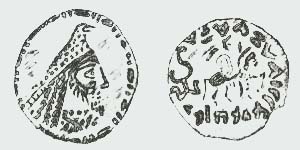 |
Tamga |
|
|
||
Let us review in more detail the inscriptions of the Turanian coins, which appeared immediately after the imitations of the coins of Eucratid.
1. Obverse. In a circular ornamental frame is an image of the vigorous bearded person, profile to the right, with à tiara on the head, in the form of an eagle. There is no inscription on the obverse.
The Turanian coins of the antique times are distinctive by their euphemism, i.e. the absence of the personal names of the rulers minting the coin, except for their titles (Fig. 3).
Reverse side. On the left side of the coin field is located a Turanian (Khoresm) tamga, resembling asymmetrical horns of a ram. Around the top are the remains of a disappeared Latin inscription. In a center part is an image of a rider. At the bottom is a linear inscription from right to left, with clear Turanian letters:
jbqoy trγn
The initial letter j of the first word differs little from the tracing of the letter ð
(th - Translator's Note) of the
Turanian alphabet. Probably, they are in fact identical. In the ancient Türkic
language are cases of a consistent gradual transition of ð into j: aðgyr - ajgyr, aðgu - aju etc., i.e. the word could be made
Dyabgu or Djabgu. Here, it
seems, is displayed the origination of this title from the Old Türkic word tanug - 'duty', 'service' and ku - 'clan', i.e. 'service to a clan'.
In the ancient nomadic and semi-nomadic societies the rulers really were not
tyrants with an unlimited authority, but the representatives of the certain powerful
clans or tribes with a broad authority.
42
In the Middle Ages, the Yabgu is a second in line after a Kagan. A Yabgu on a coin, it seems, is the Shanuy of the Chinese sources. If it so, the Yabgu is a supreme leader of the Hun empire of the antique time.
One distinctive letter graphically represents the suffix of a belonging, ug, at the end of the word Yabgug. As is visible in the inscription, the sign in the shape of a triangle adjoins to letter g on the right. However, on some types of the coins the adjoining part reminds a hyphen, i.e. a letter of the Turanian alphabet [Vainberg B.I., 1977, Table 1]. This leads to a suggestion that, it seems, the pronunciation of this word was different, including u and i in the form Yabkuik - 'belonging to Yabgu'. The similar form of a word bluik - 'his tomb sign' is found on the Bulgarian epigraphical monuments of the archaic style (religious orthodox) of 14-th c. [ Khakimzyanov F.C., 1978, 104]. The similar inflection, which S.E. Malov named “a major distinction of the ancient Türkic languages”,is found in the monument in honor of Kül Tegin [ Malov S.E., 1951. 44].
The last letter of the following word Turan was not stamped clearly, and it is a little too square for the letter n. However on some types of coins of the other rulers, for example, on a coin of some Shads, the clear inscriptions do not leave any doubt that the last letter is, nevertheless, an n [Vainberg B.I., 1977, Table XXIII, B2VII]. Therefore, the word, undoubtedly, is read as Turan.
The root tur in the word Turan, generally, is not an ethnonym of any tribe, as some historians presume [ Fray R. 1972, 67].
The ancient Türkic word tura, which has about ten forms and meanings, the most ancient of
which are very close to the word ordà (Horde),
seems to be very useful for
the reconstruction of the word Turan. Similarly to the ord à, it has several meanings,
grouped around the concepts like 'headquarters', 'house', 'possession', 'state'. Tirma means 'yurt', 'house' or
'facility', and toru - 'state'. The
word tura has undergone a long semantic evolution and ascends to the word tugra
(tugrak) - 'circle' - which connects it with the word ord>à even more. As is
known, the ancient nomadic peoples set their yurts and wagons around the encampments, protecting
the Horde or the headquarters from a sudden attack. A
derivative from the word tugra, the word Turan (Tugran) (similarly to the ancient Türkic bod - 'body', bodun - 'people'), became a name for the state.
43
In the most ancient sources that reached us, for example, in the Zoroastrian literature of the 2-nd - 1-st millenniums BC, ascending to the texts of Sasanid epoch, and in the big inscription of Shapur I, dated 260 AD, this word is also given in the form Tugran, and in the letter of the Khazarian Khagan Josef he names himself “a Togarm King” [Pletneva S.A., 1976, 7].
In the Sasanid period this word becomes a genuine name of the strong and sovereign state, which in the mentioned inscription of Shapur I is listed not isolated, but surrounded by other states, the nearest neighbors “... all Apashakhr, Kerman, Sakastan, Turan, Makuran, Paradan, India and Kushanshakhr... “[Fray R., 1972, 293].
However, it looks that in the 2-nd c. BC, during the minting of above stated coins, Turan is not a proper name, but an adjective. The word Yabgu with the suffix of belonging, Yabgug, on the coin, shows that it should be understood in the inscription not as Yabgu of Turan, but as Turan Yabgu. Here the meaning of this word is exhibited in a broader sense. It reminds a Persian word deulet: 'money', 'riches', 'possession', 'country', 'state'.
There are several types of such coins, minted on behalf of Yabgu. Not less interesting
are the copper coins regularly emitted under his name. There is a Khoresm
tamga
and not too clearly stamped title Yabgug Turan, and on the obverse is the image of a king in a crown shaped as an eagle. On one type of
the coins with an inscription Yabgug Turan, on the other side, instead of the
portrait of king, is a
tamga
in the form of a swastika (in the ancient Türkic
suastik). The similar
tamga
is
presented as an imprint of a brand on the bottom of a clay vessel from a
Hunnish settlement Ivolgino [Rudenko
S.I., 1962, 62].
44
|
Ca. AD 250 Khoresm copper coins with suastik and inscription “Turan Yabgu” http://www.sogdcoins.narod.ru/english/khwarezm/coins2.html |
|||
|---|---|---|---|
| B2V/1 | B2V/2 Camel crown | B2V/3 (cat. No?) | B2V/3 Eagle crown |
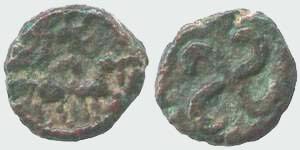 |
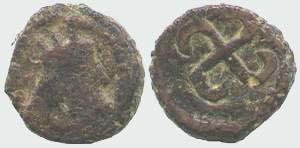 |
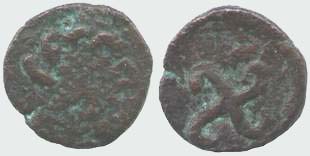 |
missing |
Rather interesting is the inscription on one of copper coins [Vainberg B.I., 1977, table. XV, B2/3]. On the obverse is minted a portrait of a king with a crown as an eagle, and on the other side is an inscription different from the previous types of the coins:
| Ca. AD 250 Khoresm copper coins with inscription “Turan Bozkukh” http://www.sogdcoins.narod.ru/english/khwarezm/coins2.html |
|---|
| B2V/4 Eagle crown ? |
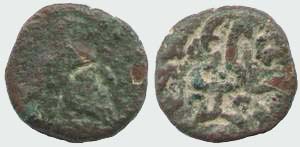 |
bzkh trγn
The inscription can be read as
Turan Bozkukh (Bozkushug?)
and the meaning of the second word, 'falcon' in the ancient Türkic, can be identified with the name of
the ruler in a crown as an eagle.
45
Among the inscriptions in the series of the antique Turanian coins with the portraits of rulers there are no other high titles, except for the title of the Yabgu, the ruler with a crown as an eagle, and therefore an unordinary person.
If to submit that the Yabgu is a Shanuy of the Chinese sources, and that the title Khagan for a supreme ruler occurs only in the Türkic period, it is possible to suggest that the person with a crown as an eagle is a major reformer and a great Shanuy of the Huns, Mode, who was a contemporary of Eucratid. In 176 BC Mode wrote in the letter to the Chinese emperor Shyao-Wyn-di about the campaign in the West, and that then 26 countries made “one house” with the Huns [Bichurin N.Ya., 1953, Vol.1, 55].
This work does not have a specifically numismatic character. We are interested, mainly, in the inscriptions on the Turanian coins. The following group of the coins with distinctive inscriptions is chronologically grouped with the coins carrying the inscription Turan Yabgu, though some types of them, it seems, were minted a little bit earlier.
2. Obverse. In a circular ornamental frame are portraits of rulers in crowns of various shapes. There are no inscriptions.
Reverse. On a left side are tamgas of the two kinds, and in the center part is a rider with imperial attributes: fluttering ribbon on the neck and a scepter in the left hand hand. Around the top are disfigured Latin letters, and at the bottom is a Turanian inscription of two - three words.
Such completely different types of the coins are united by the inscription of the
similar content. Only the shape of the individual letters differ, the originality of
which, by the way, corresponds to the type of the tamga located on the coin. Therefore,
it is possible to suggest that this not a random difference, but it shows the characteristics
of the local dialect, where the mint yard was located, the minting of which is
tied with other mints by only a common lettering.
46
The coin with the portrait of a king in the high crown and with the Khoresm tamga on the back has this inscription:
sd hnuy tγn
The inscription can be translated as
'Shad of Turan of Huns'.
The coin belongs to the early period of the minting, following the coins - imitations, when the Turanian inscription appears for the first time [Vainberg B.I., 1977, table. XVI, B111]. Probably, for this reason the inscription has some errors. The first word Shad is not stamped clearly, in the second word Huhug one of letters, u, is missing, and the letter n is drawn as a hyphen. In the third word, Turan, the letter ris missing.
The next coin with the similar content of the inscription has a special “8” figure tamga. In the circular ornamental frame is a portrait of a ruler in a headdress as a knob. On the back, around the top, are distorted Latin letters, in the middle is an image of a rider with imperial attributes, and at the bottom is a round Turanian inscription of the same contents, as on the first coin:
sd hunuk trγn
I.e 'Shad of Huns' Turan'.
The inscription scores a more precise graphics and the literacy of the engraver. The suffix of belonging in the word Huhuk is written with voiced consonant k, which, it seems, is explained by the specifics of the dialect of the city where this coin was minted.
An inscription on the following coin testifies that this not a random or erroneous writing, and in place of the Khoresm tamgas it has an “S” shaped tamga [Vainberg B.I., 1977, Table. XVII, B1IV].
On the obverse of the coin in a circular ornamental frame is located an image of a bearded ruler in a high crown. In front of the ruler is a circular arc, behind the head is some Hunnish god (or goddess), crowning the ruler.
On the back is the same inscription, but the letters are drawn with a more precise uniform handwriting. For example, the letter t and especially r in the word Turan are inscribed finely and precisely, with an especial bent at the top of the word:
sd hunuk trγn
The translation is the same, 'Shad of Huns 'Turan'.
47
Concerning the dating of the above stated coins with the portraits of the rulers and with the titles Shad, it seems that B.I.Vainberg is right, that they were made before the minting of the coins with the portrait of a king titled Yabgu in the crown as an eagle [Vainberg B.I., 1977, 64]. However, by the contents of the inscriptions, all these rulers are representatives of the Yabgu in the cities of Turan, and therefore, in the chronological relationship the coins were practically minted simultaneously, except for some short intervals.
As was noted above, the earliest coins of Turan were minted as imitations, with a portrait of Greco - Bactrian king Eucratid. To reconstruct the sequence of the minting of the Turanian coins, is important to clarify the time of the minting of the imitations . The view that they could appear only after the defeat of the Greco - Bactrians by the nomads seems to be deeply erroneous [Vainberg B.I., 1977, 49]. As the example of the minting of the imitations shows, in the Middle Ages the mint yards never imitated the coins of the defeated kings or states. For example, the Old Russian minters imitated the Byzantian coins, authoritative among the Christians. And the earlier Khazars at first imitated the Byzantian coins, but with the appearance of a more powerful Arabian Khalifat and, with heavy penetration of the Arabian coins into the Khazarian cities, they started imitating the kufic dirhams.
It seems that the appearance of the minting of the imitation coins of Eucratid, and a later change of orientation and the minting of their own coins not of the Greco - Bactrian, but of a Turanian character had more complex political relationships in the antique Turkestan.
The coin imitations with a magnificent portrait of the Eucratid could appear only during his rule and the successes of the Greco - Bactrian monetary system.
The further course of minting of the Turanian own coins appears as follows.
As it is known, later in the place of the Eucratid appear portraits of some local
rulers, and, judging by the monetary material, it seems, they were issued in a
minimum of the two centers of minting. On the back of such coins around the top,
and in a line below are disfigured Latin inscriptions. However, the
further development of minting, as stated above, did not result in the continued minting
of their own coins with the Latin inscription, and it seems,
the development was connected to the change in the political situation.
48
On the subsequent types of the coins described above appear not only the Turanian inscriptions, but also the portraits of the rulers titled as the Shads of the the Huns, i.e. the representatives of the Yabgu, the head of the Hunnish state. After a successful assimilation of the markets of Turan begins the minting of the coins with a portrait of the Yabgu of the Huns himself, with the indication of his title.
The content of the inscriptions of the following types of the antique period of the Turanian coins somewhat changes. On them the remains of the Latin letters are still preserving the remnants of the Bactrian coin decoration, which continued to be embossed not as an ornament, but to assure that the population will accept them and trust them as usual, conventional, customary coins.
3. Obverse. In a circular ornamental frame are portraits of the rulers in various shapes of the crowns. There are no inscriptions.
Reverse side. On the left side of the monetary field are tamgas of two kinds. In the center part is a rider with imperial attributes. Around the top and linearly below are the Turanian inscriptions, which contents unite these types into a group of the similar coins.
On the obverse of one of such coins is an image of a bearded ruler in a crown, and on the back is a distinctive Khoresm tamga with same length “horns” and an inscription of the following contents:
sdyqγ trγn
I.e. 'Turan of Shad'.
The inscription is rather rough [Vainberg B.I., 1977, table XXIII. B2VI].
The inscription of the following coin is also rather rough, though there is a precise Turanian tamga (B2VII):
sdyqγ trγn
I.e. 'Turan of Shad'.
It should be surmised, that the engraver has written the word Shad as Sadyig in the fuller form.
On the following coin (B2VII-2) with the usual decoration for this group of coins, i.e. with a Turanian tamga and with a rider, there is a superbly made clear inscription (Fig.4):
sdyqγ trγn
I.e. 'Turan of Shad'.
49
|
Fig. 4.
A Khoresm coin with an inscription “Turan of Shad”. http://www.persee.fr/web/revues/home/prescript/article/numi_0484-8942_2005_num_6_161_2598 http://www.sogdcoins.narod.ru/english/khwarezm/coins2.html |
||
|---|---|---|
 |
Rendition ("King Bivarsar, AD 300+"?)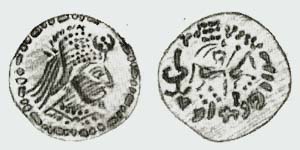 |
Tamga |
|
|
||
It is difficult to determine a particular date of the minting of the above stated types of the coins in the third group. A distinctive feature of the inscriptions of such coins is the absence of the indication that the ruler is a Shad of the “Huns”. Probably, the latter is an indicator of the relative sovereignty of the rulers of the Turan of this period. However, because the coins of such rulers still have remains of the Latin letters, in the chronological order they stand not too far from the time of the minting of the Greco - Bactrian coins.
The inscription on the following type of the coins somewhat deviates from the becoming already conventional minting of the Turanian coins on behalf of the Shads.
4. Obverse. In a circular ornamental frame is a rather rough image of a bearded ruler in a crown characteristic for the rulers of Turan. There are no inscriptions.
Reverse side. On a left side is the usual Khoresm tamga, and in the middle of a monetary field is an image of a rider with imperial attributes.
The remains of the Latin letters disappeared.
|
Khoresm coin with an inscription “Turan of Huns” http://www.persee.fr/web/revues/home/prescript/article/numi_0484-8942_2005_num_6_161_2598 http://www.sogdcoins.narod.ru/english/khwarezm/coins2.html |
||
|---|---|---|
Rendition ("Unnamed, AD 300+"?)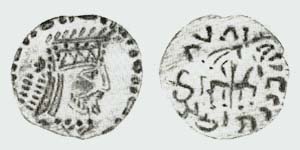 |
Tamga | |
|
|
||
Around is a distinctive inscription engraved in Turanian letters (Vainberg B.I., 1977, Table XXIII, B1]:
hνnuhq tγn
The inscription can be translated as 'Turan of Huns'.
50
The first word is read sufficiently clear. In the second word Turan the letter r is missing.
The coin, if it is really related to the time of minting of the above mentioned
coins, could be stricken not later than the 1-st c. BC, when Huns were still in
force and could claim an authority in Turan.
50
Translator's Notes
Author uses euphemism “Runic Alphabet” for the Turkic Alphabet.
Author's term “Latin” refers to the distorted Greek
legends of the Bactrian coins.
Toprak-Kale is the Kushan period capital of Chorasmia founded around the
2nd century AD with habitation up to the 7th century AD
